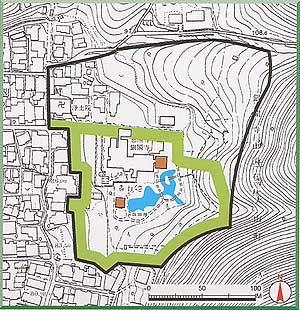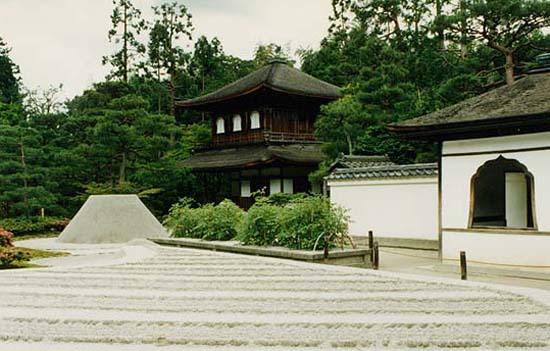| JAPANESE | |
| N. Jisho-ji (Ginkaku-ji) | |
| The simbol of the refined Higashiyama culture, the beauty of "Kotanyugen"
(profound and plain) |
|
| Establishment: The latter term of the 15th century (1482) | |
| Built in 1842 as a villa (known as the Higashiyama-dono (Higashiyama
Palace) at the base of the Higashiyama mountains by Shogun Ashikaga Yoshimasa,
Jisho-ji was converted into a Zen temple following Yoshimasa's demise. Modeled
after Saiho-ji, with the Kannoden (Ginkaku or "Silver Pavilion"),
the Togudo (Buddha hall) and other buildings situated around a pond, the
Higashiyama-dono was in Yoshimasa's day a sort of elegant artistic salon,
thronged with artists and cognoscenti. The temple for a time fell into
decline, and was restored in the mid-17th century. The Ginkaku, built in 1489, is a two-storied structure of which the ground floor is built in the wayo style of architectiure known as the shoin or "library" style, while the second floor is built in the butsudo or "Buddha-hall" style of Zen architecture. The Togudo, which served both as a hall enshrining the temple's guardian Buddha and as a study, was built in 1485. With a tsukeshoin or reading platform and with chigaidana or staggered shelves which are the oldest extant examples, the room known as the Dojinsai is regarded as the origin of the shoin-zukuri style. Deteriorated during the wartime, the temple garden is thought to have been restored, together with the rest of the temple compound, in 1615. This is an example of the chisen-kaiyu (stroll garden with a pond) style which features a central pond with many superb rocks, trees and shrubs arranged around it. The details of its stone works exhibit an exquisite delicacy of design. |
 |
 |
|
| Photo by Kanzaki Junichi | |
Map of "Historic Monuments of Ancient Kyoto" |
|